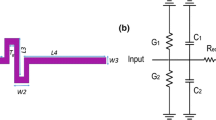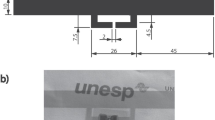Abstract
We report the modeling, and geometrical and electrical characterization, of inkjet and screen-printed patterns on different polymeric substrates for use as antennas in radio-frequency identification (RFID) applications. We compared the physical and electrical characteristics of two silver nanoparticle-based commercial inkjet-printable inks and one screen-printable silver paste, when deposited on polyimide (PI), polyethylene terephthalate (PET), and polyetherimide (PEI) substrates. First, the thickness of the inkjet-printed patterns was predicted by use of an analytical model based on printing conditions and ink composition. The predicted thickness was confirmed experimentally, and geometrical characterization of the lines was completed by measuring the root-mean-square roughness of the patterns. Second, direct-current electrical characterization was performed to identify the printing conditions yielding the lowest resistivity and sheet resistance. The minimum resistivity for the inkjet-printing method was 8.6 ± 0.8 μΩ cm, obtained by printing four stacked layers of one of the commercial inks on PEI, whereas minimum resistivity of 44 ± 7 μΩ cm and 39 ± 4 μΩ cm were obtained for a single layer of screen-printed ink on polyimide (PI) with 140 threads/cm mesh and 90 threads/cm mesh, respectively. In every case, these minimum values of resistivity were obtained for the largest tested thickness. Coplanar waveguide transmission lines were then designed and characterized to analyze the radio-frequency (RF) performance of the printed patterns; minimum transmission losses of 0.0022 ± 0.0012 dB/mm and 0.0016 ± 0.0012 dB/mm measured at 13.56 MHz, in the high-frequency (HF) band, were achieved by inkjet printing on PEI and screen printing on PI, respectively. At 868 MHz, in the ultra-high-frequency band, the minimum values of transmission loss were 0.0130 ± 0.0014 dB/mm for inkjet printing on PEI and 0.0100 ± 0.0014 dB/mm for screen printing on PI. Although the resistivity achieved is lower for inkjet printing than for screen printing, RF losses for inkjetted patterns were larger than for screen-printed patterns, because thicker layers were obtained by screen printing. Finally, several coil inductors for the HF band were also fabricated by use of both printing techniques, and were used as antennas for semi-passive smart RFID tags on plastic foil capable of measuring temperature and humidity.
Similar content being viewed by others
References
K. Finkenzeller, RFID Handbook, 2nd ed. (New York NY: Wiley, 2003).
A. Rida, L. Yang, R. Vyas, and M.M. Tentzeris, IEEE Antennas Propag. 51, 13 (2009).
R. Vyas, V. Lakafosis, A. Rida, N. Chaisilwattana, S. Travis, J. Pan, and M.M. Tentzeris, IEEE Trans. Microw. Theory Tech. 57, 1370 (2009).
M.L. Allen, K. Jaakkola, K. Nummila, and H. Seppa, IEEE Trans. Compon. Packag. Technol. 32, 325 (2009).
M. Allen, C. Lee, B. Ahn, T. Kololuoma, K. Shin, and S. Ko, Microelectron. Eng. 88, 3293 (2011).
N. Lim, J. Kim, S. Lee, N. Kim, and G. Cho, IEEE Trans. Adv. Packag. 32, 72 (2009).
S.L. Merilampi, T. Björninen, L. Ukkonen, P. Ruuskanen, and L. Sydänheimo, Int. J. Adv. Manuf. Technol. 53, 577 (2011).
J. Virtanen, J. Virkki, A.Z. Elsherbeni, L. Sydänheimo, and L. Ukkonen, Int. J. Antennas Propag. (2012). doi:10.1155/2012/801014.
L. Catarinucci, R. Colella, A. Esposito, L. Tarricone, and M. Zappatore, J. Med. Syst. 36, 3425 (2012).
K. Koski, E. Koski, J. Virtanen, T. Björninen, L. Sydänheimo, L. Ukkonen, and A.Z. Elsherbeni, Int. J. Adv. Manuf. Technol. 62, 167 (2012).
R. Sangoi, C.G. Smith, M.D. Seymour, J.N. Venkataraman, D.M. Clark, M.L. Kleper, and B.E. Kahn, J. Dispers. Sci. Technol. 25, 513 (2004).
R. Faddoul, N. Reverdy-Bruas, and A. Blayo, Sci. Eng. B Solid. 177, 1053 (2012).
R. Kattumenu, M. Rebros, M. Joyce, P.D. Fleming, and G. Neelgund, Nord. Pulp Pap. Res. J. 24, 101 (2009).
S. Merilampi, T. Laine-Ma, and P. Ruuskanen, Microelectron. Reliab. 49, 782 (2009).
Y. Kim, H. Kim, and H. Yoo, IEEE Trans. Adv. Packag. 33, 196 (2010).
D.A. Roberson, R.B. Wicker, and E. MacDonald, J. Electron. Mater. 41, 2553 (2012).
S. Magdassi, M. Grouchko, O. Berezin, and A. Kamyshny, ACS Nano 4, 1943 (2010).
B. Derby, Annu. Rev. Mater. Res. 40, 395 (2010).
F. Tao, M.E. Grass, Y. Zhang, D.R. Butcher, J.R. Renzas, Z. Liu, J.Y. Chung, B.S. Mun, M. Salmeron, and G.A. Somorjai, Science 322, 932 (2008).
J. Perelaer, P.J. Smith, D. Mager, D. Soltman, S.K. Volkman, V. Subramanian, J.G. Korvink, and U.S. Schubert, J. Mater. Chem. 20, 8446 (2010).
H.C. Jung, S. Cho, J.W. Joung, and Y. Oh, J. Electron. Mater. 36, 1211 (2007).
D.J. Lee and J.H. Oh, Thin Solid Films 518, 6352 (2010).
J.W. Kim, Y.C. Lee, J.M. Kim, W. Nah, H.S. Lee, H.C. Kwon, and S.B. Jung, Microelectron. Eng. 87, 379 (2010).
M. Tanabe, M. Nishitsuji, Y. Anda, and Y. Ota, IEEE Trans. Microw. Theory Tech. 48, 872 (2000).
Y. Feng, M. Mueller, J. Liebeskind, Q. Chen, L.R Zheng, W. Schmidt, and W. Zapka, International Conference on Digital Printing Technologies Proceedings, Minneapolis, October 26 (2011), p. 454.
V.K. Palukuru, K. Sanoda, V. Pynttäri, T. Hu, R. Mäkinen, M. Mäntysalo, J. Hagberg, and H. Jantunen, Int. J. Appl. Ceram. Technol. 8, 940 (2011).
A. Chiolerio, M. Cotto, P. Pandolfi, P. Martino, V. Camarchia, M. Pirola, and G. Ghione, Microelectron. Eng. 97, 8 (2012).
WYKO Surface Profiler Technical Reference Manual (v2.2.1) (Tucson, AZ: Veeco Process Metrology, 1999).
F. Molina-Lopez, D. Briand, and N.F. De Rooij, Sens. Actuators B Chem. 166–67, 212 (2012).
S.S. Mohan, M.D.M. Hershenson, S.P. Boyd, and T.H. Lee, IEEE J. Solid State Circuits 34, 1419 (1999).
W. Zhang, S.H. Brongersma, O. Richard, B. Brijs, R. Palmans, L. Froyen, and K. Maex, Microelectron. Eng. 76, 146 (2004).
E.H. Sondheimer, Adv. Phys. 2001, 499 (2001).
F. Lacy, Nanoscale Res. Lett. 6, 1 (2011).
N. Artunç, M.D. Bilge, and G. Utlu, Surf. Coat. Tech. 201, 8377 (2007).
D.M. Pozard, Microwave Engineering, 4 nd edn (New York NY: John Wiley & Sons, 2012).
C. Kim, M. Nogi, and S. Suganuma, J. Micromech. Microeng. 22, 3 (2012).
M. Singh, H.M. Haverinen, P. Dhagat, and G.E. Jabbour, Adv. Mater. 22, 673 (2010).
D.J. Lee, J.H. Oh, and H.S. Bae, Mater. Lett. 64, 1069 (2010).
Author information
Authors and Affiliations
Corresponding author
Rights and permissions
About this article
Cite this article
Salmerón, J.F., Molina-Lopez, F., Briand, D. et al. Properties and Printability of Inkjet and Screen-Printed Silver Patterns for RFID Antennas. J. Electron. Mater. 43, 604–617 (2014). https://doi.org/10.1007/s11664-013-2893-4
Received:
Accepted:
Published:
Issue Date:
DOI: https://doi.org/10.1007/s11664-013-2893-4




